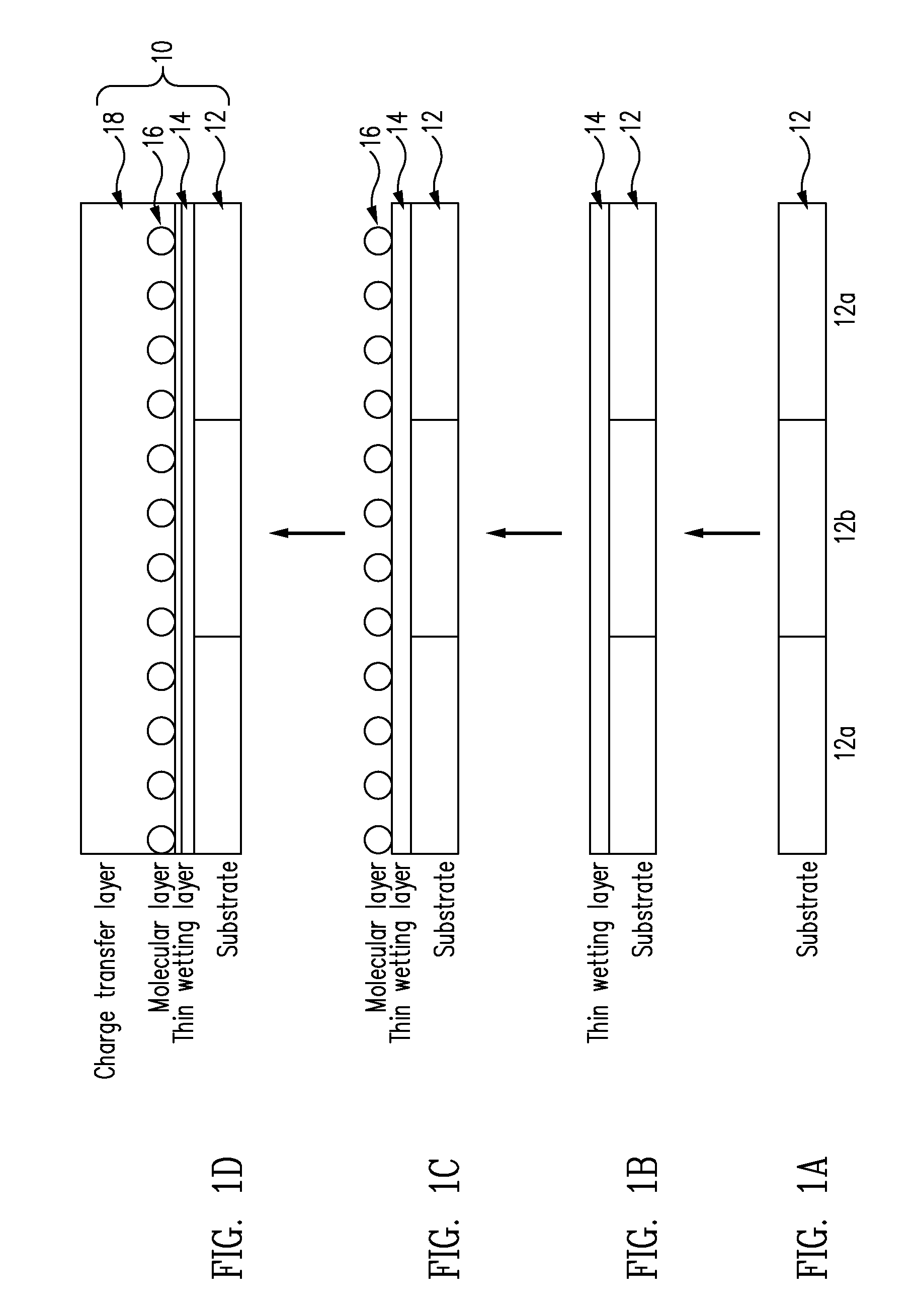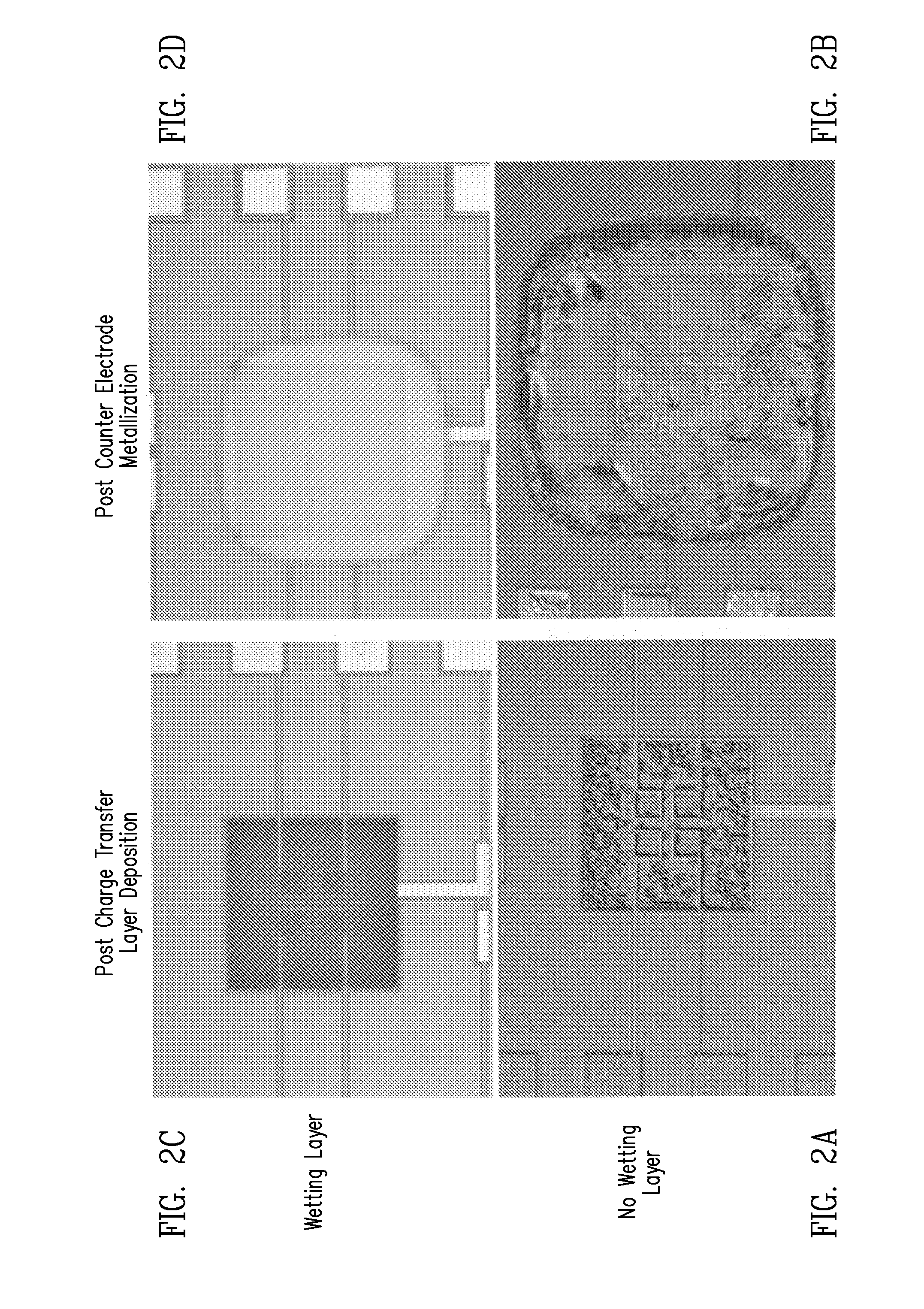Methods of Forming Thin Films for Molecular Based Devices
- Summary
- Abstract
- Description
- Claims
- Application Information
AI Technical Summary
Benefits of technology
Problems solved by technology
Method used
Image
Examples
example 1
[0178]In general, molecular based devices were formed as described above, and utilizing a wetting layer comprised of TiO2. In this example the wetting layer of TiO2 was formed atop of the molecular layer. In the exemplary embodiment, the TiO2 layer was formed after deposition of the redox-active molecular layer. H2O vapor is flowed in an inert carrier gas at a flowrate in the range of 1 to 50 sccm, for a period of time in the range of 1×10−5 to 10 seconds. This first step is carried out at a process pressure in the range of 1×10−5 to 1 Torr. The H2O vapor is then purged from the deposition chamber. Next, tetrakis(dimethylamido) Ti(IV) is flowed into the deposition chamber in an inert carrier gas at a flowrate in the range of 1 to 50 sccm, for a period of time in the range of 1×10−5 to 10 seconds. This second step is carried out at a process pressure in the range of 1×10−5 to 1 Torr. The deposition chamber is then purged. FIGS. 4A and 4B depict current and potential curves illustrati...
example 2
[0179]In this example, molecular based devices were formed with a wetting layer comprised of TiO2 deposited below the molecular layer. In the exemplary embodiment, the TiO2 layer was formed after deposition of the redox-active molecular layer. H2O vapor is flowed in an inert carrier gas at a flowrate in the range of 1 to 50 sccm, for a period of time in the range of 1×10−5 to 10 seconds. This first step is carried out at a process pressure in the range of 1×10−5 to 1 Torr. The H2O vapor is then purged from the deposition chamber. Next, tetrakis(dimethylamido) Ti(IV) is flowed into the deposition chamber in an inert carrier gas at a flowrate in the range of 1 to 50 sccm, for a period of time in the range of 1×10−5 to 10 seconds. This second step is carried out at a process pressure in the range of 1×10−5 to 1 Torr. The deposition chamber is then purged. Following the deposition of the TiO2 wetting layer, the redox-active molecular layer was deposited. FIGS. 5A and 5B depict current a...
example 3
[0180]Impedance ration verses frequency of devices formed according to the present invention were tested as shown in FIGS. 6A and 6B. Three devices were formed by first: depositing 2 cycles of TiO2 layers followed by 20 cycles of TiO2+ redox active molecular layer, using the same process conditions as reported above in Examples 1 and 2. Next, the process was carried out depositing 5 cycles of TiO2 followed by 20 cycles of the redox active molecular layer, and finally 20 cycles of the redox active molecular layer without any TiO2 layer. The speed at which the redox-active molecular layer performs was judged by measuring the impedance of the device at 1) a potential where no redox activity from the molecular layer occurs (Off Peak) and 2) at potential where the redox-active layer is oxidized and reduced (Peak). The ratio of the impedance at these two potentials is indicative of the amount of charge from the redox-active layer (magnitude of the y-axis) and the maximum speed the molecul...
PUM
| Property | Measurement | Unit |
|---|---|---|
| Temperature | aaaaa | aaaaa |
| Temperature | aaaaa | aaaaa |
| Time | aaaaa | aaaaa |
Abstract
Description
Claims
Application Information
 Login to View More
Login to View More - R&D
- Intellectual Property
- Life Sciences
- Materials
- Tech Scout
- Unparalleled Data Quality
- Higher Quality Content
- 60% Fewer Hallucinations
Browse by: Latest US Patents, China's latest patents, Technical Efficacy Thesaurus, Application Domain, Technology Topic, Popular Technical Reports.
© 2025 PatSnap. All rights reserved.Legal|Privacy policy|Modern Slavery Act Transparency Statement|Sitemap|About US| Contact US: help@patsnap.com



